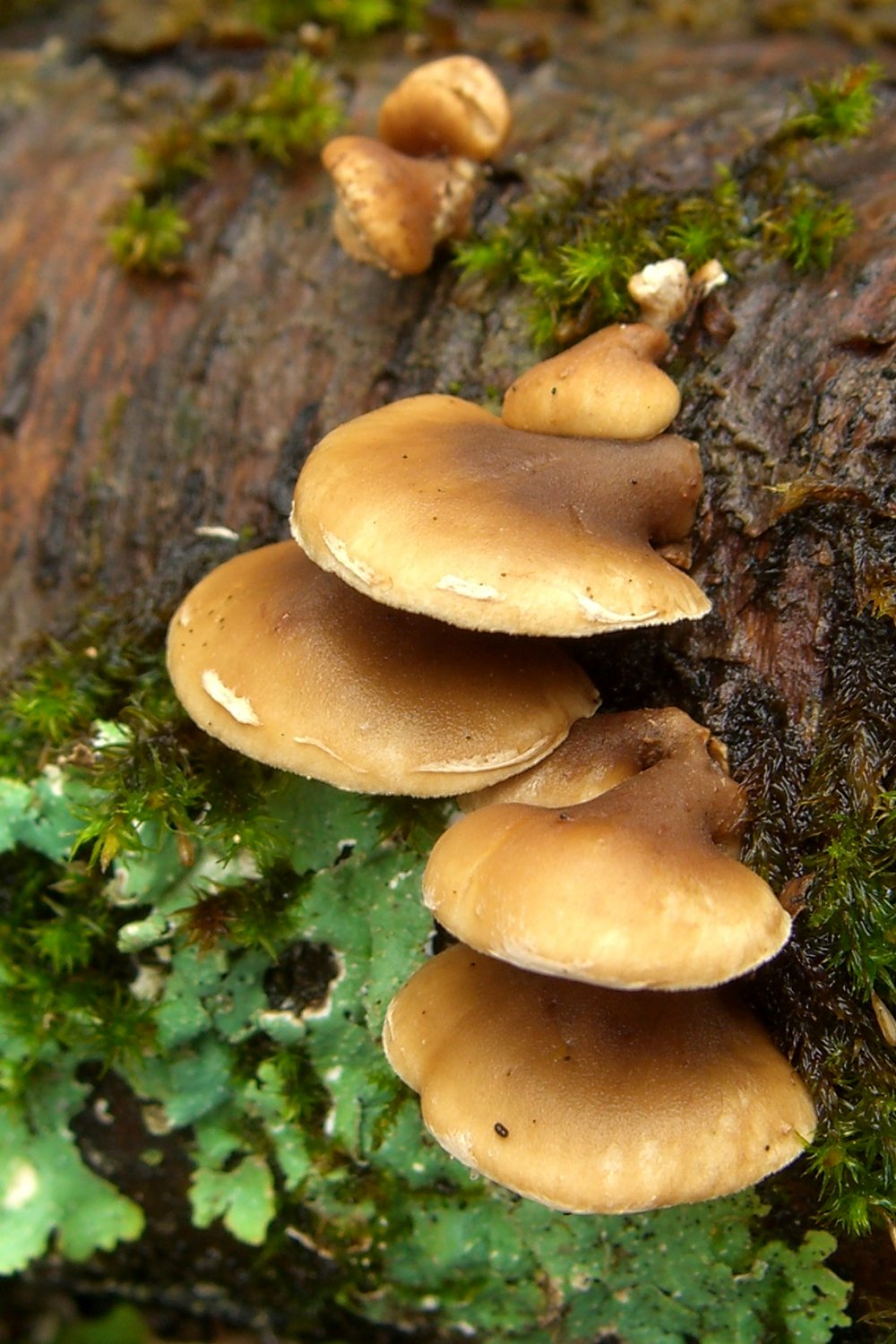Pleurotoid Fungi on:
[Wikipedia]
[Google]
[Amazon]
 Gilled
Gilled

Magic Mushrooms Effects & How To Grow Magic Mushrooms
Retrieved 2020-10-06. pleurotoid
 Gilled
Gilled fungi
A fungus ( : fungi or funguses) is any member of the group of eukaryotic organisms that includes microorganisms such as yeasts and molds, as well as the more familiar mushrooms. These organisms are classified as a kingdom, separately from ...
with laterally-attached fruiting bodies
The sporocarp (also known as fruiting body, fruit body or fruitbody) of fungi is a multicellular structure on which spore-producing structures, such as basidia or asci, are borne. The fruitbody is part of the sexual phase of a fungal life cyc ...
are said to be pleurotoid ( Gr.: ''pleurē'' + ''ōtos'' + ''-oid
In linguistics, a suffix is an affix which is placed after the stem of a word. Common examples are case endings, which indicate the grammatical case of nouns, adjectives, and verb endings, which form the conjugation of verbs. Suffixes can carry ...
'', literally "side-ear form" or "having the likeness of ''Pleurotus
''Pleurotus'' is a genus of gilled mushrooms which includes one of the most widely eaten mushrooms, '' P. ostreatus''. Species of ''Pleurotus'' may be called oyster, abalone, or tree mushrooms, and are some of the most commonly cultivated edib ...
'' ssp."). Pleurotoid fungi are typically wood-decay fungi
A wood-decay or xylophagous fungus is any species of fungus that digests moist wood, causing it to rot. Some species of wood-decay fungi attack dead wood, such as brown rot, and some, such as ''Armillaria'' (honey fungus), are parasitic and col ...
and are found on dead and dying trees and coarse woody debris
Coarse woody debris (CWD) or coarse woody habitat (CWH) refers to fallen dead trees and the remains of large branches on the ground in forests and in rivers or wetlands.Keddy, P.A. 2010. Wetland Ecology: Principles and Conservation (2nd edition). C ...
. The pleurotoid form is polyphyletic
A polyphyletic group is an assemblage of organisms or other evolving elements that is of mixed evolutionary origin. The term is often applied to groups that share similar features known as homoplasies, which are explained as a result of converg ...
, having evolved a number of times within the Basidiomycota
Basidiomycota () is one of two large divisions that, together with the Ascomycota, constitute the subkingdom Dikarya (often referred to as the "higher fungi") within the kingdom Fungi. Members are known as basidiomycetes. More specifically, Basi ...
. Many species of pleurotoid fungi are commonly referred to as "oyster" mushrooms. Laterally-attached fungi with pores rather than gills are referred to as bracket fungi
Polypores are a group of fungi that form large fruiting bodies with pores or tubes on the underside (see Delimitation for exceptions). They are a morphological group of basidiomycetes-like gilled mushrooms and hydnoid fungi, and not all polypor ...
.
Genera

Agaricales
* '' Cheimonophyllum'' * ''Crepidotus
''Crepidotus'' is a genus of fungi in the family Crepidotaceae. Species of ''Crepidotus'' all have small, convex to fan-shaped sessile caps and grow on wood or plant debris. The genus has been studied extensively, and monographs of the North Amer ...
''
* '' Hohenbuehelia''
* '' Hypsizygus''
* '' Ossicaulis''
* '' Panellus''
* '' Phyllotopsis''
* '' Pleurocybella'' — Angel wings
* ''Pleurotus
''Pleurotus'' is a genus of gilled mushrooms which includes one of the most widely eaten mushrooms, '' P. ostreatus''. Species of ''Pleurotus'' may be called oyster, abalone, or tree mushrooms, and are some of the most commonly cultivated edib ...
'' — Oyster mushrooms
* ''Resupinatus
''Resupinatus'' is a genus of fungi in the family Tricholomataceae. Species are saprobic, and often found growing on the underside of decaying wood or sides of decaying woody substrates. The generic name is derived from the Latin ''resupinus'' (b ...
'' — Oysterlings
* '' Schizophyllum''
* '' Tectella''
Polyporales
* ''Lentinus
''Lentinus'' is a genus of fungi in the family Polyporaceae. The genus is widely distributed, with many species found in subtropical regions.
The genus name ''Lentinus'' is derived from the Latin ''lent'', meaning "pliable", and ''inus'', meani ...
''
* ''Panus
''Panus'' is a genus of fungi in the family Polyporaceae.
Species
* (Senthil. & S.K.Singh) Senthil. (2015)
*''Panus bacillisporus'' Kauffman (1930)
*''Panus bartlettii'' Massee (1907)
*''Panus biersianus'' Har. & Pat. (1914)
*''Panus brunneipes' ...
''
Russulales
* ''Lactifluus
''Lactifluus'' is one of three genera of mushroom-forming fungi containing species commonly named " milk-caps", the others being ''Lactarius'' and ''Multifurca''. It has been separated from ''Lactarius'' based on molecular phylogenetic evidence ...
'' - some species
* ''Lentinellus
''Lentinellus'' is a genus of white rot, wood decay, lamellate agaric in the family Auriscalpiaceae, further characterized in part by rough-walled, amyloid spores produced on lamellae with jagged edges. Typically, thick-walled hyphae in the fru ...
''
* ''Russula
''Russula'' is a very large genus composed of around 750 worldwide species of ectomycorrhizal mushrooms. They are typically common, fairly large, and brightly colored – making them one of the most recognizable genera among mycologists and mushr ...
'' - some species
References
External links
* * *{{cite web, title=Pleurotoid Fungi, publisher=MushroomHobby.com, first= Dimitar, last=Bojantchev, url=http://www.mushroomhobby.com/Gallery/Pleurotoid/index.htm, accessdate=2011-04-08Magic Mushrooms Effects & How To Grow Magic Mushrooms
Retrieved 2020-10-06. pleurotoid